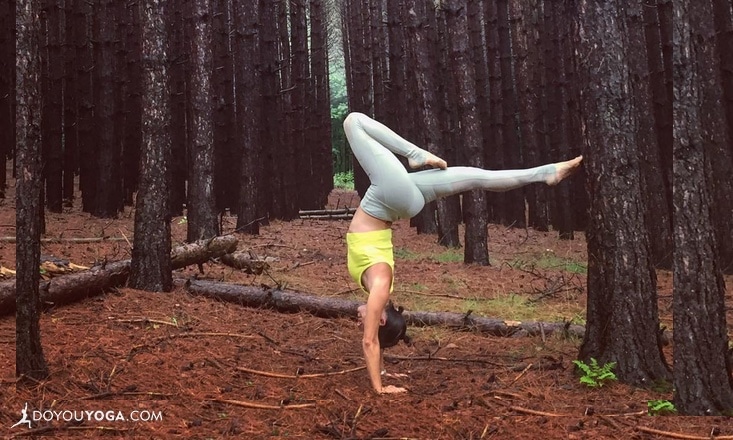For some, meditation is as ingrained into daily ritual as brushing teeth or eating breakfast. For others, it’s a tool used once a week to check in or quiet the mind when insomnia or stress and anxiety hits. And yet for another group, meditation is elusive and intimidating — something they’d love to do but have no idea where to start.
If you’ve been around the yoga block for a while now, you may have heard the name Patanjali – the wise man who complied 196 sutras, or guidelines of sorts, that make up the widely accepted handbook of ancient and modern yoga.
The Yoga Sutras of Patanjali outline a framework for yoga practice comprised of 8 different limbs. I like to think of it as a tree with 8 main branches extending from the trunk and some of the branches have even smaller branches extending from them.
The physical movement we practice on the mat is called asana. Believe it or not, asana is only one of the eight different limbs of Patanjali’s guide to yoga. The traditional goal of asana is to prepare the physical body for meditation, so your body has the stamina, strength and flexibility to be able to sit in meditation for hours at a time.
Because the benefits of meditation are most noticeable when it is a daily practice, I’ve pulled together a few easy tips to incorporate meditation into your existing yoga practice. So whether you meditate for an hour every morning or you're just about to embark on your own meditation journey, these small suggestions can bring a little bit more meditation into your practice without much additional time commitment:
1. Breathing – focus on the breath.
This is my favorite way to add a little meditation flavor to my asana practice.
To meditate on the breath, simply notice it. Notice the way it feels coming out of your nostrils. Notice how it lifts your chest and fills your belly as you inhale. Notice how it squeezes that belly and contracts the chest as you exhale. Notice its speed, its texture, its temperature.
Notice it without judgement. Allow yourself to just be with your breath – don’t control it or modify it – just notice it. I breathe in. I breathe out. And on and on and on.
2. Observing – focus on the sensation.
Through the practice of yoga, we experience many different physical sensations ranging from the burning sensation in the quads while holding Chair Pose to the tension in the arms as they become like dead weight extending out far and wide in Warrior II.
It’s easy to let the monkey mind take hold during these moments. You start thinking of that big meeting you have tomorrow or the emails that you have to respond to after class or perhaps you start judging your sadist teacher that is making you stay in Extended Side Angle for far too many breaths and you start to anticipate release from the pose. It’s moments like these I like to practice mindfulness, to tune into my inner body and focus on what is purely sensation.
Zero in on one part of the body and notice all there is to notice about it. Take your back foot in Warrior II, for example. Notice how the knife edge presses into the mat. Feel the mat beneath it. Feel it, in return, pressing into your foot. Notice the texture. Notice the pressure. Notice the temperature. Notice your inner arch and devote all of your mental energy to the entire experience of that back foot.
3. Listening – focus on the language.
Listen, really listen, to the words coming out of your teacher’s mouth. If we are splitting hairs, this technique is probably more along the lines of practicing mindfulness than practicing meditation, but it’s a fantastic practice nonetheless.
Move with the language, not before it, but with it. Sure, Upward Facing Dog usually follows high to low push-up. But listen for the cues, move with the language.
I find this particularly relevant for anyone that practices Bikram, Ashtanga or other regimented styles of yoga or if you go to your favorite teacher all the time and can anticipate what s/he will say next. But it’s also relevant for when you’ve completed a sequence on the left side and now it’s time for the right side. Use each and every cue from your teacher to bring mindful thought to your movements.
4. Speaking – focus on a mantra.
In traditional meditation practices, your teacher prescribes a mantra for a student's unique needs. In the interest of starting to bring meditation to the mat, try thoughtful, purposeful mantra repetition or audible recitation to center in before class or round out your practice at the end.
5. Seeing – focus on one spot.
An open-eye meditation is particularly useful to incorporate during the standing series of your asana practice. For example, in Tree Pose or Dancer's Pose, pick one spot (also known as drishti) and focus or softly gaze upon it for the entirety of the posture. Keep the eyes resting on the same drishti while you change sides.
With these five tips, meditation doesn't have to be intimidating but rather something that you can incorporate into your existing asana practice. In addition to these, try arriving early or staying later after class to sit in meditation. The more often you do it, the more benefits you'll notice.
How do you like to bring meditation on to your yoga mat? We’d love to hear in the comments below.
Photo credit: dinaivas


